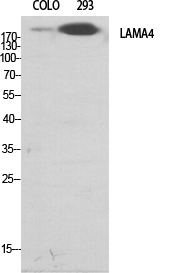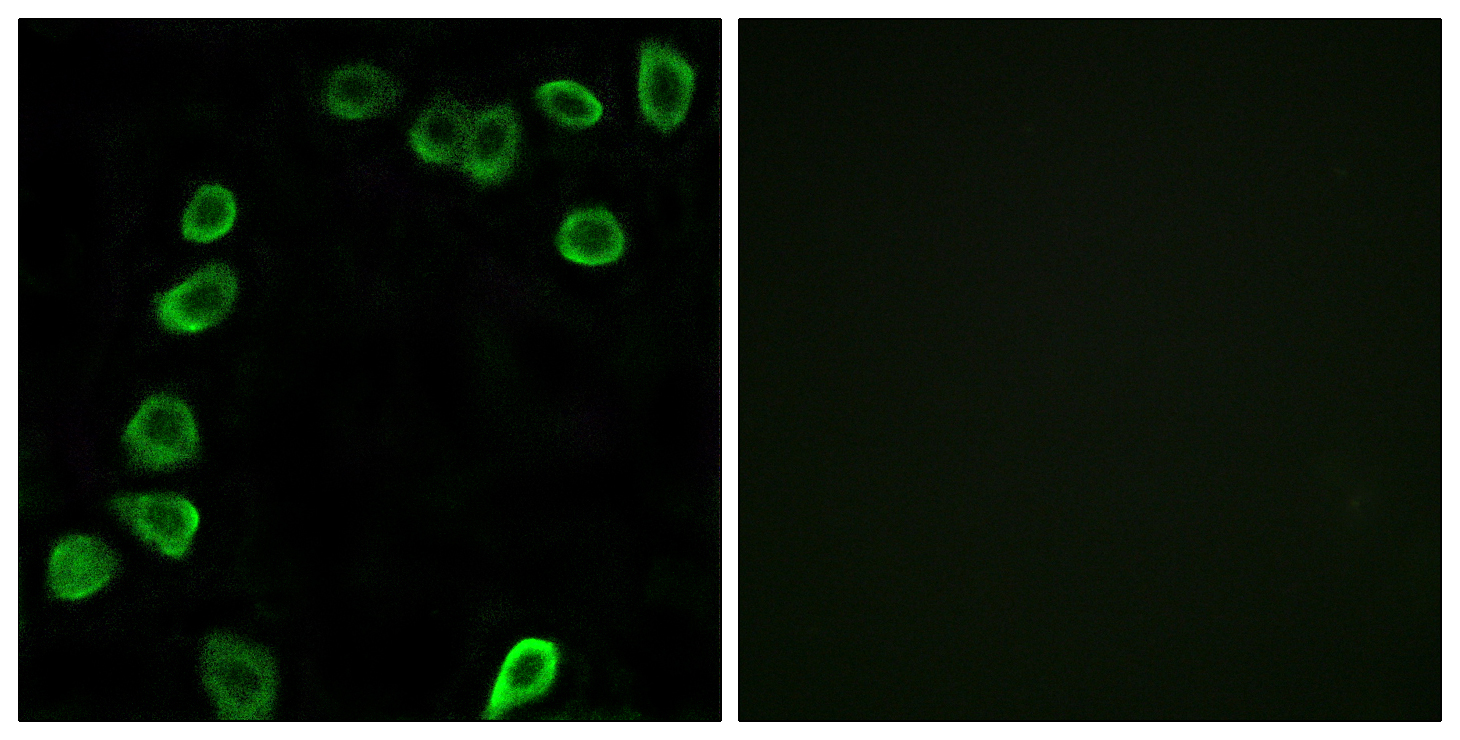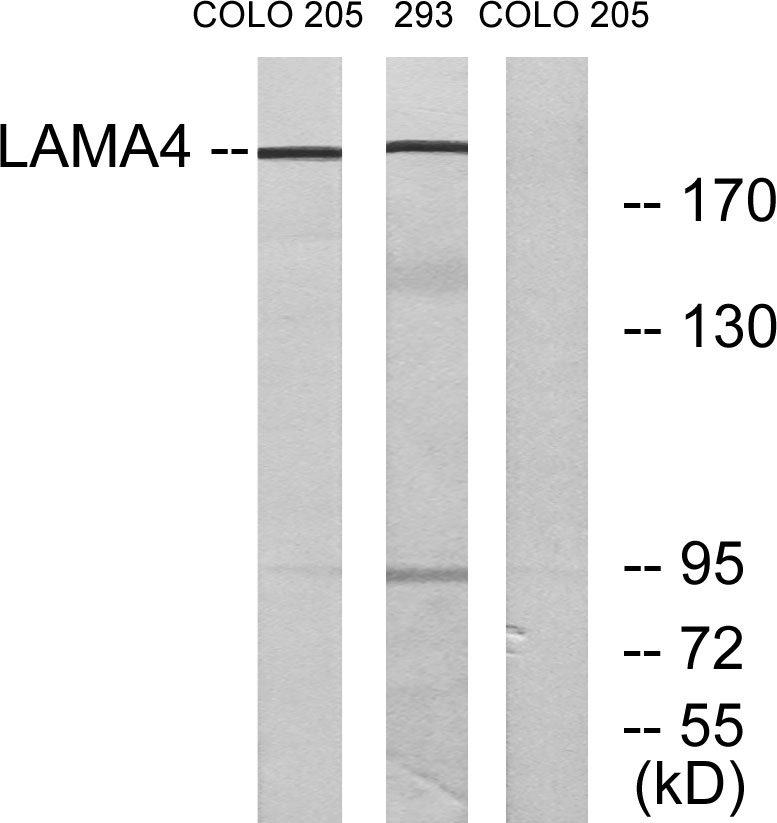Laminin α-4 Polyclonal Antibody
- Catalog No.:YT2526
- Applications:WB;IHC;IF;ELISA
- Reactivity:Human;Mouse
- Target:
- Laminin α-4
- Fields:
- >>PI3K-Akt signaling pathway;>>Focal adhesion;>>ECM-receptor interaction;>>African trypanosomiasis;>>Toxoplasmosis;>>Amoebiasis;>>Human papillomavirus infection;>>Pathways in cancer;>>Small cell lung cancer
- Gene Name:
- LAMA4
- Protein Name:
- Laminin subunit alpha-4
- Human Gene Id:
- 3910
- Human Swiss Prot No:
- Q16363
- Mouse Gene Id:
- 16775
- Mouse Swiss Prot No:
- P97927
- Immunogen:
- The antiserum was produced against synthesized peptide derived from human LAMA4. AA range:481-530
- Specificity:
- Laminin α-4 Polyclonal Antibody detects endogenous levels of Laminin α-4 protein.
- Formulation:
- Liquid in PBS containing 50% glycerol, 0.5% BSA and 0.02% sodium azide.
- Source:
- Polyclonal, Rabbit,IgG
- Dilution:
- WB 1:500 - 1:2000. IHC 1:100 - 1:300. IF 1:200 - 1:1000. ELISA: 1:40000. Not yet tested in other applications.
- Purification:
- The antibody was affinity-purified from rabbit antiserum by affinity-chromatography using epitope-specific immunogen.
- Concentration:
- 1 mg/ml
- Storage Stability:
- -15°C to -25°C/1 year(Do not lower than -25°C)
- Other Name:
- LAMA4;Laminin subunit alpha-4;Laminin-14 subunit alpha;Laminin-8 subunit alpha;Laminin-9 subunit alpha
- Observed Band(KD):
- 203kD
- Background:
- Laminins, a family of extracellular matrix glycoproteins, are the major noncollagenous constituent of basement membranes. They have been implicated in a wide variety of biological processes including cell adhesion, differentiation, migration, signaling, neurite outgrowth and metastasis. Laminins are composed of 3 non identical chains: laminin alpha, beta and gamma (formerly A, B1, and B2, respectively) and they form a cruciform structure consisting of 3 short arms, each formed by a different chain, and a long arm composed of all 3 chains. Each laminin chain is a multidomain protein encoded by a distinct gene. Several isoforms of each chain have been described. Different alpha, beta and gamma chain isomers combine to give rise to different heterotrimeric laminin isoforms which are designated by Arabic numerals in the order of their discovery, i.e. alpha1beta1gamma1 heterotrimer is laminin 1. The biol
- Function:
- caution:Gene LAMA4 was formerly called LAMA3.,domain:Domain G is globular.,domain:The alpha-helical domains I and II are thought to interact with other laminin chains to form a coiled coil structure.,function:Binding to cells via a high affinity receptor, laminin is thought to mediate the attachment, migration and organization of cells into tissues during embryonic development by interacting with other extracellular matrix components.,similarity:Contains 4 laminin EGF-like domains.,similarity:Contains 5 laminin G-like domains.,subcellular location:Major component.,subunit:Laminin is a complex glycoprotein, consisting of three different polypeptide chains (alpha, beta, gamma), which are bound to each other by disulfide bonds into a cross-shaped molecule comprising one long and three short arms with globules at each end.,tissue specificity:In adult, strong expression in heart, lung, ovary
- Subcellular Location:
- Secreted, extracellular space, extracellular matrix, basement membrane. Major component.
- Expression:
- In adult, strong expression in heart, lung, ovary small and large intestines, placenta, liver; weak or no expression in skeletal muscle, kidney, pancreas, testis, prostate, brain. High expression in fetal lung and kidney. Expression in fetal and newborn tissues is observed in certain mesenchymal cells in tissues such as smooth muscle and dermis.
- June 19-2018
- WESTERN IMMUNOBLOTTING PROTOCOL
- June 19-2018
- IMMUNOHISTOCHEMISTRY-PARAFFIN PROTOCOL
- June 19-2018
- IMMUNOFLUORESCENCE PROTOCOL
- September 08-2020
- FLOW-CYTOMEYRT-PROTOCOL
- May 20-2022
- Cell-Based ELISA│解您多样本WB检测之困扰
- July 13-2018
- CELL-BASED-ELISA-PROTOCOL-FOR-ACETYL-PROTEIN
- July 13-2018
- CELL-BASED-ELISA-PROTOCOL-FOR-PHOSPHO-PROTEIN
- July 13-2018
- Antibody-FAQs
- Products Images

- Western Blot analysis of various cells using Laminin α-4 Polyclonal Antibody diluted at 1:500
.jpg)
- Western Blot analysis of 293 cells using Laminin α-4 Polyclonal Antibody diluted at 1:500

- Immunofluorescence analysis of NIH/3T3 cells, using LAMA4 Antibody. The picture on the right is blocked with the synthesized peptide.

- Immunohistochemistry analysis of paraffin-embedded human heart tissue, using LAMA4 Antibody. The picture on the right is blocked with the synthesized peptide.

- Western blot analysis of lysates from COLO and 293 cells, using LAMA4 Antibody. The lane on the right is blocked with the synthesized peptide.



